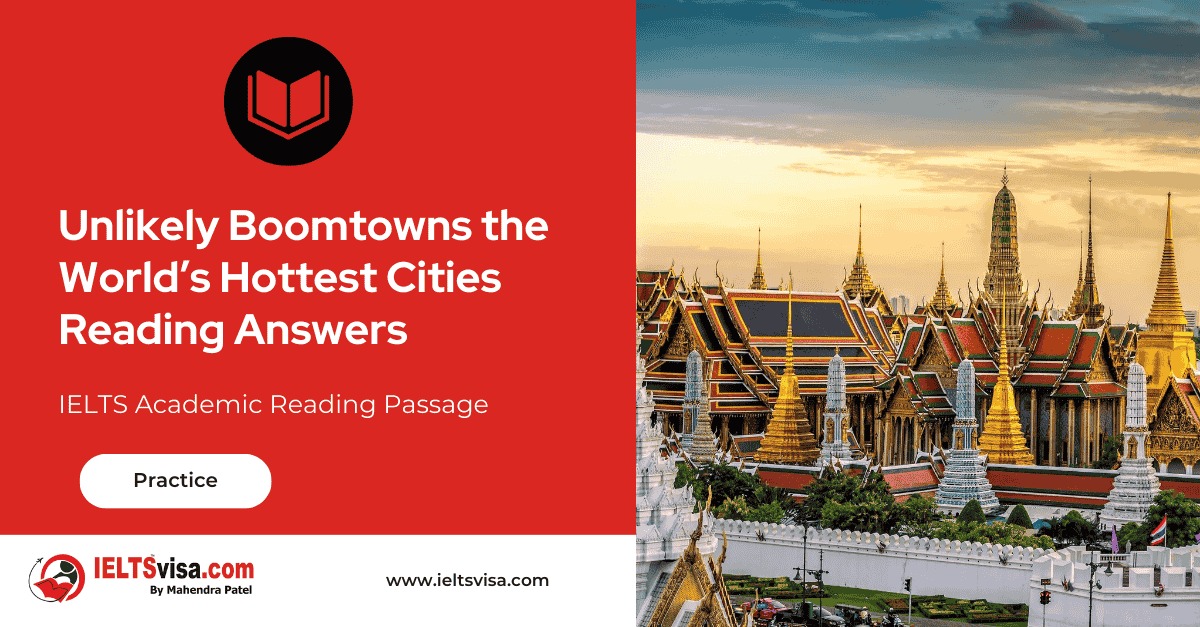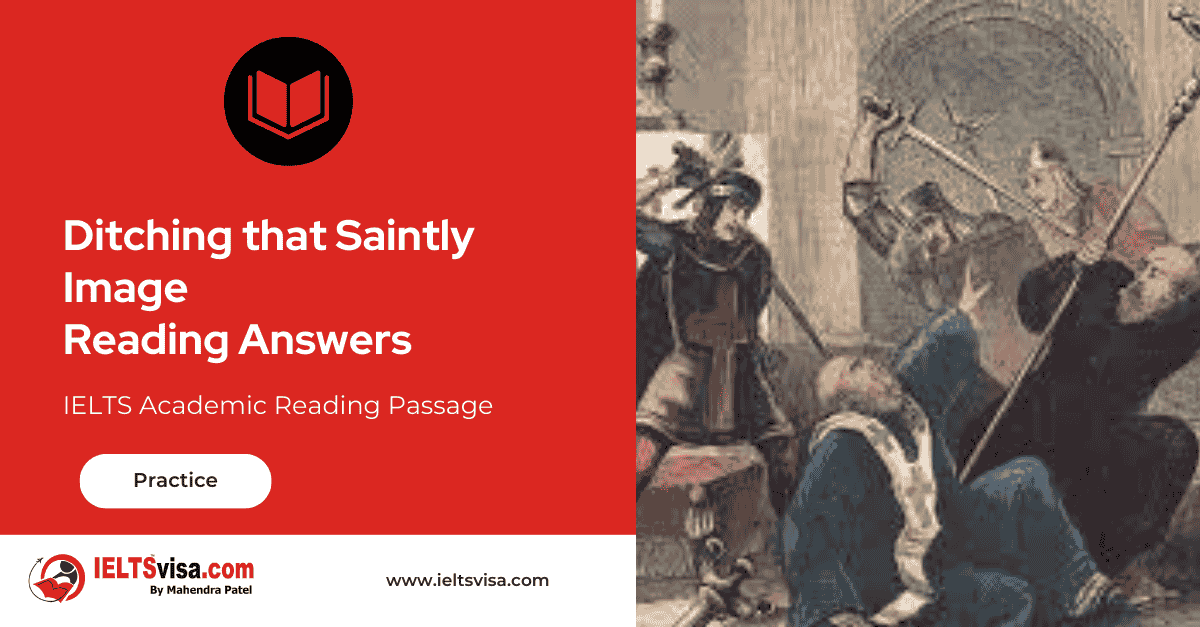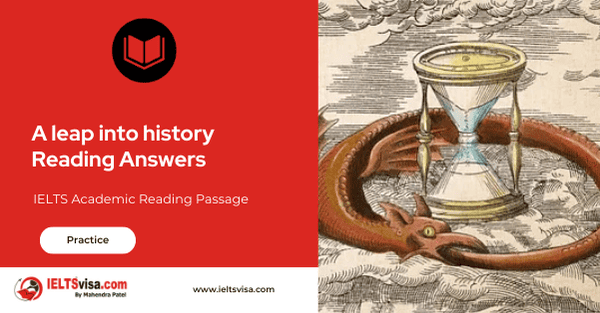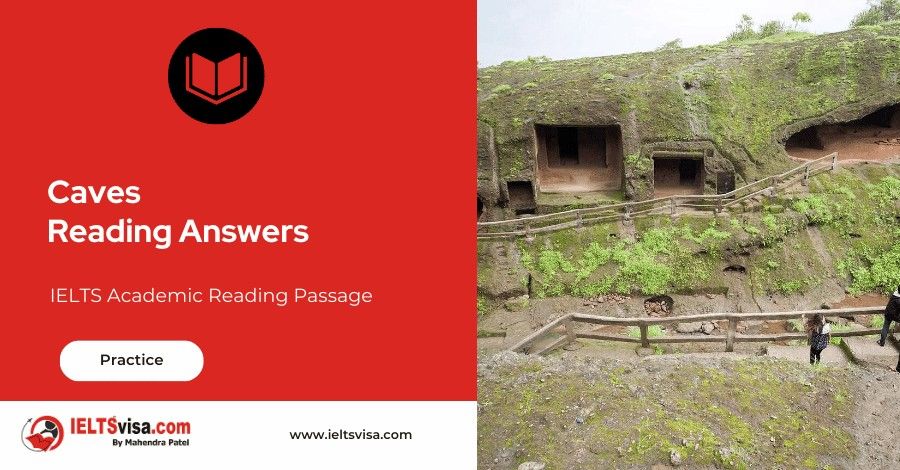Unlikely Boomtowns the World’s Hottest Cities Reading Answers
IELTS Academic Reading Passage
Megacities like London, New York, and Tokyo loom large in our imaginations. They are still
associated with fortune, fame, and the future. They can dominate national economies and politics. The last fifty years have been their era, as the number of cities with more than ten million people grew from two to twenty.
But with all respect to the science fiction novelists who have envisioned a future of urban giants, their day is over. The typical growth rate of the population within a megacity has slowed from more than eight percent in the 1980s to less than half that over the last five years, and numbers are expected to be static in the next quarter-century. Instead, the coming years will belong to a smaller, humbler relation – the Second City.
Within a few years, more people will live in cities than in the countryside for the first time in human history. But increasingly, the urban core itself is downsizing. Already, half the city dwellers in the world live in metropolises with fewer than half-a-million residents. Second Cities from exurbs, residential areas outside the suburbs of a town, to regional centers are booming.
Between 2000 and 2015, the world’s smallest cities (with under 500,000 people) will grow by 23 percent, while the next smallest (One million to five million people) will grow by 27 percent. This trend is the result of dramatic shifts including the global real estate bubble; increasing international migration; cheaper transport; new technologies, and the fact that the baby-boom generation is reaching retirement age.
The emergence of Second Cities has flowed naturally (if unexpectedly) from the earlier success of the megacities. In the 1990s, megacities boomed as global markets did. This was particularly true in areas with high tech or ‘knowledge-based’ industries like finance. Bonuses got bigger, bankers got richer and real estate prices in the world’s most sought-after cities soared. The result has been the creation of what demographer William Frey of Washington-based Brookings Institute calls ‘gated regions’ in which both the city and many of the surrounding suburbs have become unaffordable for all but the very wealthy.
Economically, after a city reaches a certain size its productivity starts to fall,’ notes Mario Pezzini, head of the regional competitiveness division of the OECD. He puts the tipping point at about six million people, after which costs, travel times, and the occasional chaos create which the center of the city may be a great place, but only for the rich, and the outlying areas become harder to live and work in.
One reaction to this phenomenon is further sprawl – high prices in the urban core and traditional suburbs drive people to distant exurbs with extreme commutes into big cities. As Frey notes, in the major US metropolitan areas, average commuting times have doubled over the last fifteen years.
Why does one town become a booming Second City, while another fails? The answer hinges on whether a community has the wherewithal to exploit the forces pushing people and businesses out of the megacities. One key is excellent transport links, especially to the biggest commercial centers. Though barely a decade old, Goyang is South Korea’s fastest-growing city in part because it is 30 minutes by subway from Seoul.
Another growth driver for Second Cities is the decentralization of work, driven in large part by new technologies. While more financial deals are done now in big capitals like New York and London than ever before, it is also clear that plenty of booming services industries are leaving for ‘Rising Urban stars’ like Dubai, Montpellier and Cape Town. These places have not only improved their Internet backbones but often have technical institutes and universities that turn out the kinds of talent that populate growth industries.
Consider Montpellier, France, a case study in urban decentralisation. Until the 1980s, it was like a big Mediterranean village. Once the high-speed train lines were built, Parisians began pouring in for weekend breaks. Some bought houses, creating a critical mass of middle-class professionals who began taking advantage of flexible working systems to do three days in Paris, and two down South, where things seemed less pressured.
Soon big companies began looking at the area, a number of medical technology and electronic firms came to town, and IBM put more investment into service businesses there. To cater to the incoming professionals, the city began building amenities: an opera house, a tram line to discourage cars in the city centre. The result, says French urban- planning expert Nacima Baron, is that the city is now full of cosmopolitan business people. It’s a new society’.
All this means that Second Cities won’t stay small. Indeed countries are actively promoting their growth. Italy, for example, is trying to create tourist hubs of towns close to each other with distinctive buildings and offering different yet complementary cultural activities. Devolution of policy-making power is leaving many lesser cities freer than ever to shape their destinies. To them all: This is your era. Don’t blow it.
Questions 1-3
Choose three letters A-G. Which THREE of the following statements is true of megacities according to the text
A. They tend to lead the way in terms of fashion.
B. Their population has ceased to expand.
C. They reached their peak in the second half of the twentieth century.
D. 50 percent of the world’s inhabitants now live In them,
E. They grew rich in profits from the manufacturing industry.
F. Their success begins to work against them at a certain stage.
G. It is no longer automatically advantageous to base a company there
Questions 4 – 6
Choose three letters A-G
The list below gives some possible reasons why small towns can turn into successful Second Cities. Which THREE of these reasons are mentioned by the writer of the text
A. the existence of support services for foreign workers
B. the provision of cheap housing for older people
C. the creation of efficient access routes
D. the ability to attract financial companies
E. the expertise to keep up with electronic development
F. the maintenance of a special local atmosphere
G. the willingness to imitate international style architecture
Questions 7 – 13
Complete the summary by using the list A-R below.
Urban Decentralisation
It is becoming increasingly obvious that large numbers of 7……are giving up their expensive premises in the megacities and relocating to smaller cities like Montpellier. One of the attractions of Montpellier is the presence of a good 8…… that can provide them with the necessary skilled workforce.
Another Important factor for Montpellier was the arrival of visitors from the 9……………… The introduction of the 10………meant that increasing numbers were able to come for short stays. Of these, a significant proportion decided to get a base in the city. The city council soon realized that they needed to provide an appropriate 11……….for their new inhabitants. In fact, the 12…………… among them liked the more relaxed lifestyle so much that they took advantage of any 13……….arrangements offered by their firms to spend more of the week in Montpellier.
A. urban centers
B. finance companies
C. flexible
D. tram line
E. cosmopolitan
F. service industries
G. capital
H. high-speed train
I. infrastructure
J. unskilled workers
K. jobs
L. medical technology
M. professionals
N. European Union
O. amenities
P. middle age
Q. overtime
R. University

Solution For: Unlikely Boomtowns the World’s Hottest Cities
Reading Answers
| 1. B | 8. R |
| 2. F | 9. G |
| 3. G | 10. H |
| 4. C | 11. O |
| 5. E | 12. M |
| 6. F | 13. C |
| 7. F |
Review and Practice
- Regularly practice with IELTS reading samples and time yourself to get used to the pressure of the exam.
- Review your mistakes to understand where you went wrong and how to avoid similar errors in the future.
Our Books
Master IELTS Speaking Part 1
IELTS Writing Task 1 Book
IELTS Writing Task 2 Book
Unlikely Boomtowns the World’s Hottest Cities Reading Answers Explanation
Comin Soon
Practice IELTS Other Modules
IELTS Listening
The IELTS Listening test assesses how well you can understand spoken English in various contexts. It lasts about 30 minutes and is divided into four sections with a total of 40 questions. The listening tasks become increasingly difficult as the test progresses.
IELTS Academic Reading
The IELTS Academic Reading section assesses your ability to understand and interpret a variety of texts in academic settings. It is designed to evaluate a range of reading skills, including skimming for gist, reading for main ideas, reading for detail, understanding inferences, and recognizing a writer's opinions and arguments.
IELTS Speaking
The IELTS Speaking test assesses your ability to communicate in English on everyday topics. It lasts 11-14 minutes and consists of three parts: introduction, cue card, and a discussion based on the cue card topic.
IELTS General Reading
IELTS General Reading tests your ability to understand and interpret various types of texts. Here are some key areas and types of content you can expect to encounter in the reading section, along with tips for effective preparation.
IELTS Academic Writing Task 1
In IELTS Academic Writing Task 1, you are presented with a visual representation of information, such as graphs, charts, tables, or diagrams, and you are required to summarize, compare, or explain the data in your own words.
IELTS General Writing Task 1
In IELTS General Writing Task 1, you are required to write a letter based on a given situation. The letter can be formal, semi-formal, or informal, depending on the prompt. Here’s a breakdown of the key components to include in your letter
IELTS Academic Writing Task 2
In IELTS Academic Writing Task 2, you are required to write an essay in response to a question or topic. Here’s a guide to help you understand the essential elements of this task
IELTS Exam Tips
To succeed in the IELTS exam, practice regularly, familiarize yourself with the test format, improve your vocabulary, develop time management skills, and take mock tests to build confidence.
Grammer for IELTS
Grammar is the foundation of effective communication in English. Understanding tense usage, subject-verb agreement, and sentence structure enhances clarity and coherence in writing and speaking.
Vocabulary for IELTS
Vocabulary plays a crucial role in the IELTS (International English Language Testing System) exam, especially in the Speaking and Writing sections. Here’s an overview of why vocabulary is important and how it impacts your performance
RECENT IELTS SAMPLES QUESTIONS AND ANSWERS
Ditching that Saintly Image
A. Charities, it is still widely believed, are separate from the government, staffed entirely...
Sleep apnea
1. Sleep apnea is a common sleeping disorder. It affects a number of adults comparable to the...
A leap into history
A Between the Inishowen peninsula, north west of Derry, and the Glens of Antrim, in the east...
Caves
Caves are natural underground spaces commonly those into which man can enter. There are three...
Cure-all Pills: Myths or Reality?
Browse the shelves of any health food shop or pharmacy and you’ll find dozens of dietary...
Dawn Of The Robots
A. At first glance, it appeared to be a typical suburban road accident. A Land Rover...













